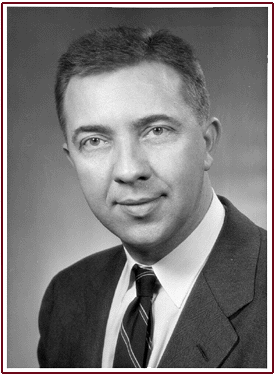

James A. Van Allen was a pathbreaking astrophysicist best known for
his work in magnetospheric physics. Van Allen graduated from Iowa Wesleyan College
in 1935. He then enrolled at the University of Iowa where he received an M.S.
in 1936 and a Ph.D. in 1939. Following school, Van Allen accepted employment
with the Department of Terrestrial Magnetism at the Carnegie Institution of
Washington, where he studied photodisintegration. In April 1942 Van Allen moved
to the Applied Physics Laboratory at the Johns Hopkins University where he worked
to develop a rugged vacuum tube. He also helped to develop proximity fuzes for
weapons used in the war, especially for anti-aircraft projectiles used by the
U.S. Navy. By the fall of 1942, he had been commissioned as an officer in the
Navy and was sent to the Pacific to field test and complete operational requirements
for the proximity fuzes. Upon completing his assignments in World War II, Van
Allen returned to civilian life and began working in high altitude research,
first for the Applied Physics Laboratory and, after 1950, at the University
of Iowa. Van Allen's career took an important turn in 1955 when he and several
other American scientists developed proposals for the launch of a scientific
satellite as part of the research program conducted during the International
Geophysical Year (IGY) of 1957-1958. After the success of the Soviet Union with
Sputnik 1, Van Allen's Explorer spacecraft was approved for launch on a Redstone
rocket. It flew on 31 January 1958, and returned enormously important scientific
data about the radiation belts circling the Earth. Van Allen became a celebrity
because of the success of that mission, and he went on to other important scientific
projects in space. In one way or another, Van Allen was involved in the first
four Explorer probes, the first Pioneers, several Mariner efforts, and the orbiting
geophysical observatory. James A. Van Allen retired from the University of Iowa
in 1985 to become Carver Professor of Physics, Emeritus, after having served
as the head of the Department of Physics and Astronomy from 1951. See James
A. Van Allen, Origins of Magnetospheric Physics (Washington, DC: Smithsonian
Institution Press, 1983); David E. Newton, "James A. Van Allen," in Emily J.
McMurray, ed., Notable Twentieth-Century Scientists (New York: Gale Research
Inc., 1995), pp. 2070-72; "James A. Van Allen," biographical file, NASA Historical
Reference Collection, NASA History Division, NASA Headquarters, Washington,
DC. Also click here for a NASA
tribute to Van Allen.

Last Updated: November 20, 2006